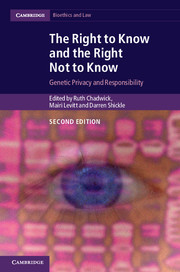Book contents
- Frontmatter
- Contents
- List of contributors
- Acknowledgements
- Introduction
- Part I Philosophical and legal issues
- Part II Issues in genetics
- 4 Biobanks and feedback
- 5 Suspects, victims and others: producing and sharing forensic genetic knowledge
- 6 Empowered by choice?
- 7 DIY genetics: the right to know your own genome
- 8 Genomics, inconvenient truths and accountability
- Part III Emerging issues
- Index
- References
8 - Genomics, inconvenient truths and accountability
Published online by Cambridge University Press: 05 September 2014
- Frontmatter
- Contents
- List of contributors
- Acknowledgements
- Introduction
- Part I Philosophical and legal issues
- Part II Issues in genetics
- 4 Biobanks and feedback
- 5 Suspects, victims and others: producing and sharing forensic genetic knowledge
- 6 Empowered by choice?
- 7 DIY genetics: the right to know your own genome
- 8 Genomics, inconvenient truths and accountability
- Part III Emerging issues
- Index
- References
Summary
Recently, genetics and genomics have become consumer products, moving beyond the research lab and outside the clinic into the daily life of modern citizens. Direct-to-consumer (DTC) marketed genetic tests are probably the best-known example, the ‘products’ being actually lab services, as Barbara Prainsack discusses in Chapter 7 of this volume. DNA-based genealogy tests to find out more about one’s ancestry were among the first on the market. Now that technology developments have led to the increasing availability of sophisticated but affordable tests, questions concerning genomics applications arise in a new context for individuals and families, and at a larger scale for communities and societies. While individual-centred, clinical and non-clinical use of genetic testing is booming, other areas of genetic research are also changing, as can be seen in, for example, human anthropology and population genetics. New insights and, in particular, new technologies in genomic science are leveraging the broad field of biomedicine and they imply changed patterns of accountability in research. Therefore, established normative frameworks that refer to classical (human) genetics require careful inspection and they may need to be adjusted in order to be applicable to the new knowledge from the genomic sciences.
We aim to contribute to that revision by reviewing some classic cases that challenge our thinking about ethics and accountability in the sciences in various disciplines.
- Type
- Chapter
- Information
- The Right to Know and the Right Not to KnowGenetic Privacy and Responsibility, pp. 116 - 130Publisher: Cambridge University PressPrint publication year: 2014

